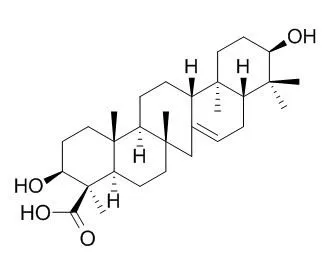METHODS AND RESULTS:
Activity-guided fractionation of an ethanol extract of Lycopodium cernuum for Candida albicans secreted aspartic proteases (SAP) inhibition resulted in the identification of six new (1-6) and four known (7-10) serratene triterpenes, along with the known apigenin-4'-O-(2' ',6' '-di-O-p-coumaroyl)-beta-D-glucopyranoside (11). On the basis of spectroscopic analysis, the structures of 1-10 were established as 3beta,14alpha,15alpha,21beta,29-pentahydroxyserratane-24-oic acid (lycernuic acid C, 1), 3beta,14alpha,15alpha,21beta-tetrahydroxyserratane-24-oic acid (lycernuic acid D, 2), 3beta,14beta,21beta-trihydroxyserratane-24-oic acid (lycernuic acid E, 3), 3beta,21beta,29-trihydroxy-16-oxoserrat-14-en-24-methyl ester (lycernuic ketone A, 4), 3alpha,21beta,29-trihydroxy-16-oxoserrat-14-en-24-methyl ester (lycernuic ketone B, 5), 3alpha,21beta,24-trihydroxyserrat-14-en-16-one (lycernuic ketone C, 6), 3beta,21beta-dihydroxyserrat-14-en-24-oic acid (Lycernuic acid A, 7), 3beta,21beta,29-trihydroxyserrat-14-en-24-oic acid (lycernuic acid B, 8), serrat-14-en-3beta,21beta-diol (9), and serrat-14-en-3beta,21alpha-diol (10). The 13C NMR data for the known compounds 7 and 8 are reported for the first time.
CONCLUSIONS:
Compounds 1 and 11 showed inhibitory effects against C. albicans secreted aspartic proteases (SAP) with IC50 of 20 and 8.5 microg/mL, respectively, while the other compounds were inactive. |






 Cell. 2018 Jan 11;172(1-2):249-261.e12. doi: 10.1016/j.cell.2017.12.019.IF=36.216(2019)
Cell. 2018 Jan 11;172(1-2):249-261.e12. doi: 10.1016/j.cell.2017.12.019.IF=36.216(2019) Cell Metab. 2020 Mar 3;31(3):534-548.e5. doi: 10.1016/j.cmet.2020.01.002.IF=22.415(2019)
Cell Metab. 2020 Mar 3;31(3):534-548.e5. doi: 10.1016/j.cmet.2020.01.002.IF=22.415(2019) Mol Cell. 2017 Nov 16;68(4):673-685.e6. doi: 10.1016/j.molcel.2017.10.022.IF=14.548(2019)
Mol Cell. 2017 Nov 16;68(4):673-685.e6. doi: 10.1016/j.molcel.2017.10.022.IF=14.548(2019)